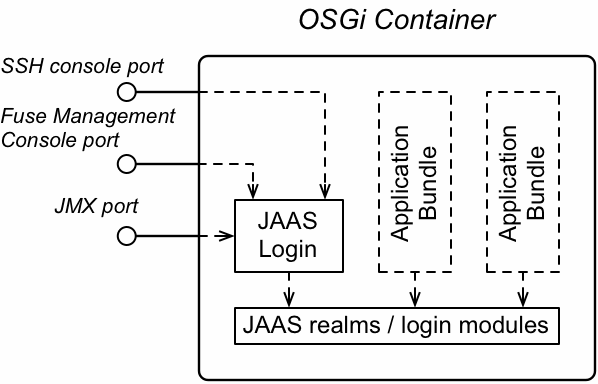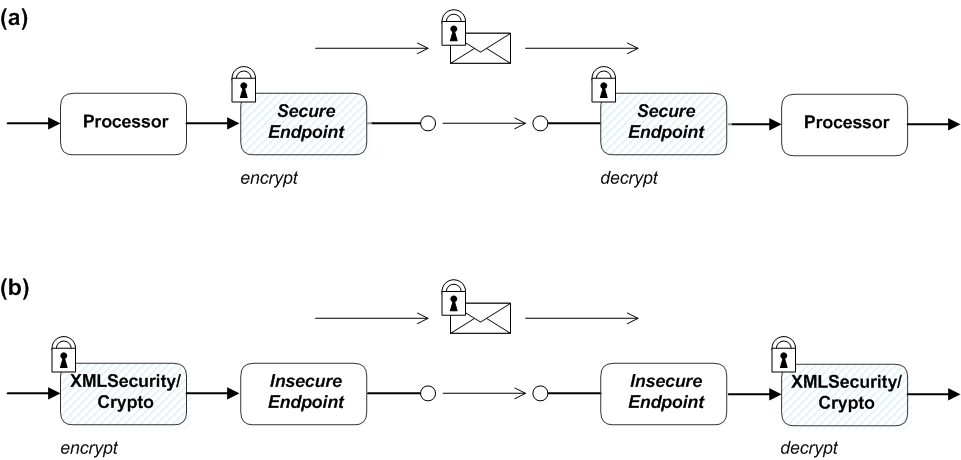Chapter 1. Security Architecture
Abstract
In the OSGi container, it is possible to deploy applications supporting a variety of security features. Currently, only the Java Authentication and Authorization Service (JAAS) is based on a common, container-wide infrastructure. Other security features are provided separately by the individual products and components deployed in the container.
1.1. OSGi Container Security
Overview
Figure 1.1, “OSGi Container Security Architecture” shows an overview of the security infrastructure that is used across the container and is accessible to all bundles deployed in the container. This common security infrastructure currently consists of a mechanism for making JAAS realms (or login modules) available to all application bundles.
Figure 1.1. OSGi Container Security Architecture
JAAS realms
A JAAS realm or login module is a plug-in module that provides authentication and authorization data to Java applications, as defined by the Java Authentication and Authorization Service (JAAS) specification.
Red Hat Fuse supports a special mechanism for defining JAAS login modules (in either a Spring or a blueprint file), which makes the login module accessible to all bundles in the container. This makes it easy for multiple applications running in the OSGi container to consolidate their security data into a single JAAS realm.
karaf realm
The OSGi container has a predefined JAAS realm, the karaf realm. Red Hat Fuse uses the karaf realm to provide authentication for remote administration of the OSGi runtime, for the Fuse Management Console, and for JMX management. The karaf realm uses a simple file-based repository, where authentication data is stored in the InstallDir/etc/users.properties file.
You can use the karaf realm in your own applications. Simply configure karaf as the name of the JAAS realm that you want to use. Your application then performs authentication using the data from the users.properties file.
Console port
You can administer the OSGi container remotely either by connecting to the console port with a Karaf client or using the Karaf ssh:ssh command. The console port is secured by a JAAS login feature that connects to the karaf realm. Users that try to connect to the console port will be prompted to enter a username and password that must match one of the accounts from the karaf realm.
JMX port
You can manage the OSGi container by connecting to the JMX port (for example, using Java’s JConsole). The JMX port is also secured by a JAAS login feature that connects to the karaf realm.
Application bundles and JAAS security
Any application bundles that you deploy into the OSGi container can access the container’s JAAS realms. The application bundle simply references one of the existing JAAS realms by name (which corresponds to an instance of a JAAS login module).
It is essential, however, that the JAAS realms are defined using the OSGi container’s own login configuration mechanism—by default, Java provides a simple file-based login configuration implementation, but you cannot use this implementation in the context of the OSGi container.
1.2. Apache Camel Security
Overview
Figure 1.2, “Apache Camel Security Architecture” shows an overview of the basic options for securely routing messages between Apache Camel endpoints.
Figure 1.2. Apache Camel Security Architecture
Alternatives for Apache Camel security
As shown in Figure 1.2, “Apache Camel Security Architecture”, you have the following options for securing messages:
Endpoint security—part (a) shows a message sent between two routes with secure endpoints. The producer endpoint on the left opens a secure connection (typically using SSL/TLS) to the consumer endpoint on the right. Both of the endpoints support security in this scenario.
With endpoint security, it is typically possible to perform some form of peer authentication (and sometimes authorization).
Payload security—part (b) shows a message sent between two routes where the endpoints are both insecure. To protect the message from unauthorized snooping in this case, use a payload processor that encrypts the message before sending and decrypts the message after it is received.
A limitation of payload security is that it does not provide any kind of authentication or authorization mechanisms.
Endpoint security
There are several Camel components that support security features. It is important to note, however, that these security features are implemented by the individual components, not by the Camel core. Hence, the kinds of security feature that are supported, and the details of their implementation, vary from component to component. Some of the Camel components that currently support security are, as follows:
- JMS and ActiveMQ—SSL/TLS security and JAAS security for client-to-broker and broker-to-broker communication.
- Jetty—HTTP Basic Authentication and SSL/TLS security.
- CXF—SSL/TLS security and WS-Security.
- Crypto—creates and verifies digital signatures in order to guarantee message integrity.
- Netty—SSL/TLS security.
- MINA—SSL/TLS security.
- Cometd—SSL/TLS security.
- glogin and gauth—authorization in the context of Google applications.
Payload security
Apache Camel provides the following payload security implementations, where the encryption and decryption steps are exposed as data formats on the marshal() and unmarshal() operations
XMLSecurity data format
The XMLSecurity data format is specifically designed to encrypt XML payloads. When using this data format, you can specify which XML element to encrypt. The default behavior is to encrypt all XML elements. This feature uses a symmetric encryption algorithm.
For more details, see http://camel.apache.org/xmlsecurity-dataformat.html.
Crypto data format
The crypto data format is a general purpose encryption feature that can encrypt any kind of payload. It is based on the Java Cryptographic Extension and implements only symmetric (shared-key) encryption and decryption.
For more details, see http://camel.apache.org/crypto.html.

